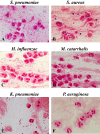Validation of sputum Gram stain for treatment of community-acquired pneumonia and healthcare-associated pneumonia: a prospective observational study
- PMID: 25326650
- PMCID: PMC4287475
- DOI: 10.1186/1471-2334-14-534
Validation of sputum Gram stain for treatment of community-acquired pneumonia and healthcare-associated pneumonia: a prospective observational study
Abstract
Background: The usefulness of sputum Gram stain in patients with community-acquired pneumonia (CAP) is controversial. There has been no study to evaluate the diagnostic value of this method in patients with healthcare-associated pneumonia (HCAP). The purpose of this study was to evaluate the usefulness of sputum Gram stain in etiological diagnosis and pathogen-targeted antibiotic treatment of CAP and HCAP.
Methods: We conducted a prospective observational study on hospitalized patients with pneumonia admitted to our hospital from August 2010 to July 2012. Before administering antibiotics on admission, Gram stain was performed and examined by trained physicians immediately after sputum samples were obtained. We analyzed the quality of sputum samples and the diagnostic performance of Gram stain. We also compared pathogen-targeted antibiotic treatment guided by sputum Gram stain with empirical treatment.
Results: Of 670 patients with pneumonia, 328 were CAP and 342 were HCAP. Sputum samples were obtained from 591 patients, of these 478 samples were good quality. The sensitivity and specificity of sputum Gram stain were 62.5% and 91.5% for Streptococcus pneumoniae, 60.9% and 95.1% for Haemophilus influenzae, 68.2% and 96.1% for Moraxella catarrhalis, 39.5% and 98.2% for Klebsiella pneumoniae, 22.2% and 99.8% for Pseudomonas aeruginosa, 9.1% and 100% for Staphylococcus aureus. The diagnostic yield decreased in patients who had received antibiotics or patients with suspected aspiration pneumonia. Pathogen-targeted treatment provided similar efficacy with a decrease in adverse events compared to empirical treatment.
Conclusions: Sputum Gram stain is highly specific for the etiologic diagnosis and useful in guiding pathogen-targeted antibiotic treatment of CAP and HCAP.
Figures


Similar articles
-
Prospective study of the usefulness of sputum Gram stain in the initial approach to community-acquired pneumonia requiring hospitalization.Clin Infect Dis. 2000 Oct;31(4):869-74. doi: 10.1086/318151. Epub 2000 Oct 12. Clin Infect Dis. 2000. PMID: 11049763
-
Usefulness of gram-stained sputum obtained just after administration of antimicrobial agents as the earliest therapeutic indicator for evaluating the effectiveness of empiric therapy in community-acquired pneumonia caused by pneumococcus or Moraxella catarrhalis.J Infect Chemother. 2013 Jun;19(3):517-23. doi: 10.1007/s10156-012-0475-7. Epub 2012 Oct 17. J Infect Chemother. 2013. PMID: 23073648
-
Assessment of the usefulness of sputum Gram stain and culture for diagnosis of community-acquired pneumonia requiring hospitalization.Med Sci Monit. 2008 Apr;14(4):CR171-6. Med Sci Monit. 2008. PMID: 18376343
-
Usefulness of sputum gram stain for etiologic diagnosis in community-acquired pneumonia: a systematic review and meta-analysis.BMC Infect Dis. 2019 May 10;19(1):403. doi: 10.1186/s12879-019-4048-6. BMC Infect Dis. 2019. PMID: 31077143 Free PMC article.
-
Sputum Gram Stain for Bacterial Pathogen Diagnosis in Community-acquired Pneumonia: A Systematic Review and Bayesian Meta-analysis of Diagnostic Accuracy and Yield.Clin Infect Dis. 2020 Jul 27;71(3):499-513. doi: 10.1093/cid/ciz876. Clin Infect Dis. 2020. PMID: 31504334 Free PMC article.
Cited by
-
Gradient diffusion antibiogram used directly on bronchial aspirates for a rapid diagnosis of ventilator-associated pneumonia.Antimicrob Resist Infect Control. 2019 Nov 14;8:176. doi: 10.1186/s13756-019-0640-1. eCollection 2019. Antimicrob Resist Infect Control. 2019. PMID: 31807286 Free PMC article.
-
Klebsiella Pneumoniae sepsis deteriorated by uncontrolled underlying disease in a decontamination worker in Fukushima, Japan.J Occup Health. 2016 Jun 16;58(3):320-2. doi: 10.1539/joh.15-0292-CS. Epub 2016 Apr 22. J Occup Health. 2016. PMID: 27108638 Free PMC article.
-
2018 recommendations for the management of community acquired pneumonia.J Bras Pneumol. 2018 Sep-Oct;44(5):405-423. doi: 10.1590/S1806-37562018000000130. J Bras Pneumol. 2018. PMID: 30517341 Free PMC article.
-
Point-of-care urine Gram stain led to narrower-spectrum antimicrobial selection for febrile urinary tract infection in adolescents and adults.BMC Infect Dis. 2022 Mar 1;22(1):198. doi: 10.1186/s12879-022-07194-9. BMC Infect Dis. 2022. PMID: 35227212 Free PMC article.
-
Normal Respiratory Flora as a Cause of Community-Acquired Pneumonia.Open Forum Infect Dis. 2020 Sep 15;7(9):ofaa307. doi: 10.1093/ofid/ofaa307. eCollection 2020 Sep. Open Forum Infect Dis. 2020. PMID: 32968689 Free PMC article.
References
-
- Mandell LA, Wunderink RG, Anzueto A, Bartlett JG, Campbell GD, Dean NC, Dowell SF, File TM, Jr, Musher DM, Niederman MS, Torres A, Whitney CG, Infectious Diseases Society of America; American Thoracic Society Infectious diseases society of America/American thoracic society consensus guidelines on the management of community-acquired pneumonia in adults. Clin Infect Dis. 2007;44(Suppl 2):S27–72. doi: 10.1086/511159. - DOI - PMC - PubMed
-
- Woodhead M, Blasi F, Ewig S, Garau J, Huchon G, Ieven M, Ortqvist A, Schaberg T, Torres A, van der Heijden G, Read R, Verheij TJ, Joint Taskforce of the European Respiratory Society and European Society for Clinical Microbiology and Infectious Diseases Guidelines for the management of adult lower respiratory tract infections - full version. Clin Microbiol Infect. 2011;17(Suppl 6):E1–59. doi: 10.1111/j.1469-0691.2011.03672.x. - DOI - PMC - PubMed
Pre-publication history
-
- The pre-publication history for this paper can be accessed here:http://www.biomedcentral.com/1471-2334/14/534/prepub
Publication types
MeSH terms
Substances
LinkOut - more resources
Full Text Sources
Other Literature Sources
Medical
Miscellaneous

